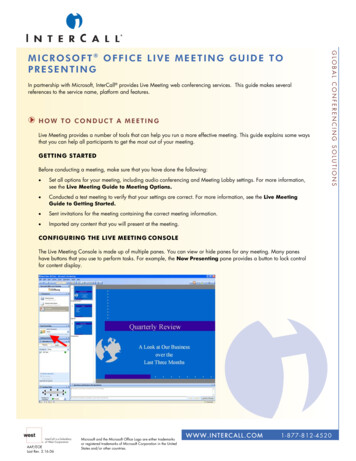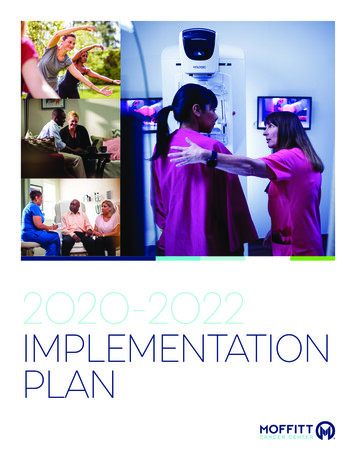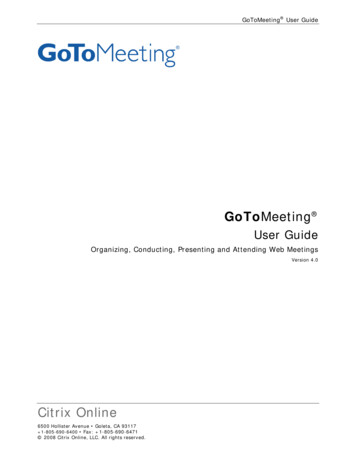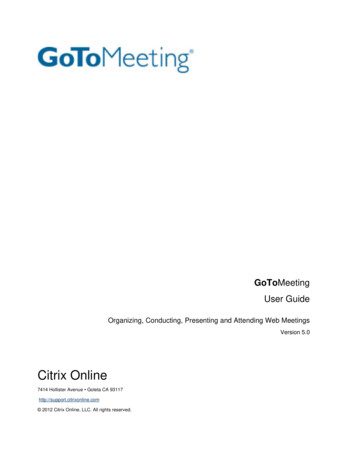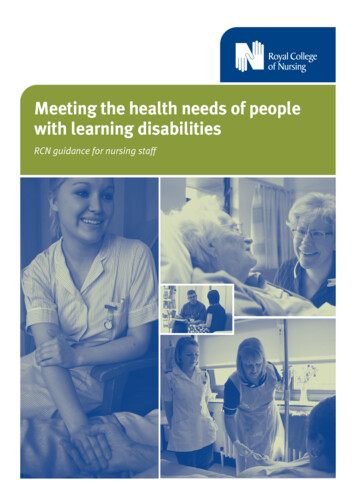
Transcription
Meeting the health needs of peoplewith learning disabilitiesRCN guidance for nursing staff
AcknowledgementsThe RCN Learning Disability Forum would like to thankall the contributors and members of the steering groupfor their time and valuable comments in developing thisupdated guide, which was originally published in 2006and revised in 2007. It would also like to thank theSouth London and Maudsley NHS Foundation Trust forits support.This document was written by:Steve Hardy, Training and Consultancy Manager,Estia Centre, South London and Maudsley NHSFoundation TrustPeter Woodward, Senior Lecturer in Learning DisabilityNursing, University of GreenwichPetrea Woolard, Lead Clinician, Speech and LanguageTherapy, Southwark Community Team for Adults withLearning DisabilitiesDr Tom Tait, Director, Growing Older with LearningDisability LtdRCN Learning Disability ForumExternal Advisory GroupFor a full list of advisory group members, see appendix.Published by the Royal College of Nursing, 20 Cavendish Square, London, W1G 0RN 2011 Royal College of Nursing. All rights reserved. No part of this publication may be reproduced, stored in a retrieval system, or transmitted in any formor by any means electronic, mechanical, photocopying, recording or otherwise, without prior permission of the Publishers or a licence permitting restrictedcopying issued by the Copyright Licensing Agency, 90 Tottenham Court Road, London W1T 4LP. This publication may not be lent, resold, hired out orotherwise disposed of by ways of trade in any form of binding or cover other than that in which it is published, without the prior consent of the Publishers.RCN Legal DisclaimerThis publication contains information, advice and guidance to help members of the RCN. It is intended for use within the UK but readers are advised thatpractices may vary in each country and outside the UK.The information in this booklet has been compiled from professional sources, but its accuracy is not guaranteed. Whilst every effort has been made toensure the RCN provides accurate and expert information and guidance, it is impossible to predict all the circumstances in which it may be used.Accordingly, the RCN shall not be liable to any person or entity with respect to any loss or damage caused or alleged to be caused directly or indirectly bywhat is contained in or left out of this guidance.
ROYAL COLLEGE OF N URSI NGMeeting the health needs of peoplewith learning disabilitiesRCN guidance for nursing staffContents1Introduction22Defining learning disabilities23Health needs and services44Specific health needs75Policy and law106Specialist services147Supporting access to services158Resources19Appendix: Contributors and steering group231
LEARNING DISABILITIES12IntroductionDefining learningdisabilitiesThis updated guide has been developed to supportregistered nurses and nursing students in primary andsecondary care, who are trained in fields other thanlearning disabilities, to deliver high quality health careto people with learning disabilities.People with learning disabilities are unique individualswith their own likes and dislikes, history, and opinions,and have the same rights as anyone else.It highlights the specific health needs of people withlearning disabilities, supports staff in making theirservices more accessible, and includes sources offurther information. While this guide is aimed at nurseswho may find themselves working with adults withlearning disabilities, those working with children mayalso find it useful.Learning disabilities affect about 1.5 million people inthe UK; a learning disability is a common, lifelongcondition which is neither an illness nor disease. Theterm is used in relation to individuals who have thefollowing characteristics:This guidance was originally developed in 2006 inresponse to a resolution passed at RCN Congress 2004,demanding that people with learning disabilities haveequal access to health care services. Members of theRCN Learning Disability Forum subsequently requestedthe development of a guide to support colleagues inother fields of nursing to achieve this objective.Ga significant impairment of intelligenceGa significant impairment of adaptive functioningGthe age of onset occurs before adulthood (in otherwords, in the developmental period) (BPS, 2000).Measuring intelligenceIntelligence is formally measured through a cognitiveassessment which gives people an IQ (intelligencequotient) score. An IQ test examines an individual’sabilities, including comprehension, expression,knowledge, abstract thinking, memory and problemsolving skills. The test is generally administered by aqualified psychologist – usually a clinical psychologist.Many local learning disabilities’ services across the UKhave also developed comprehensive guides and trainingpackages in this area. This guide does not aim to replacethese, but has been developed because of the RCN’sunique ability to reach the wider nursing workforce.The average IQ score for the UK population is 100 with arange of 15 points either side. Anyone with an IQ scorebetween 85 and 115, therefore, is said to be of averageintelligence.People with learning disabilities can be said to have eithera significant impairment in intellectual functioning (anIQ of between 55 and 69) or a severe impairment inintellectual functioning (an IQ below 55) (BPS, 2000).Sometimes people are classified as having mild,moderate, severe or profound learning disabilities.Moderate, severe and profound learning disabilities allrelate to a severe impairment in intellectual functioning.In the past people with learning disabilities were given‘mental ages’. However, this is now accepted as adegrading term that takes no account of peoples’ lifeexperiences.2
ROYAL COLLEGE OF N URSI NGNot everybody who has learning disabilities has an IQtest. The test is generally used when it is unclear if theperson has learning disabilities, and the information isused to help decide if that person is eligible forspecialist learning disability services.with milder learning disabilities might live bythemselves or semi-independently, with a few hours ofsupport each day.People who need a greater level of support, and do notlive in the family home, might live in supported housingwhich is generally managed by private or voluntaryorganisations, although some are managed by healthand social services.Social functioningThe term ‘social functioning’ refers to the skills deemednecessary to deal with life and to functionindependently. These include cooking, communicating,taking care of personal hygiene, developing socialrelationships and using community facilities.Some people who present with severely challenging oroffending behaviour, and/or have severe and enduringmental health problems as well as learning disabilities,might live in more specialist services which provideassessment and treatment. People with learningdisabilities who have committed offences might begiven a custodial sentence and, therefore, live in prison.Developmental periodRecognising people withlearning disabilitiesMost causes of learning disabilities occur before, duringor soon after birth, but become apparent during thedevelopmental period which extends from earlychildhood up to when an individual reaches the age of 18.In the context of health care, it is important to be able torecognise if a person has learning disabilities. Thisenables nurses to make adjustments to their nursingpractice and provide signposting to services that mayoffer extra support.Some people experience brain damage in adult life,following an accident or through the effects of diseasefor example, which can result in a significantimpairment of intelligence and social functioning.However, these individuals are not considered to havelearning disabilities since their disabilities wereacquired after their brain developed and are likely to useacquired brain injury services.Some people have obvious learning disabilities, dueperhaps to their increased need for support, but it canbe difficult to recognise people with milder learningdisabilities.There are a number of points nurses can consider,although they are not totally indicative of learningdisabilities:TerminologyThe term ‘learning disabilities’ replaced ‘mentalhandicap’ in the early 1990s and is used throughout theUK, although other terms, such as ‘intellectualdisabilities’, are increasingly being used internationally.Some people with learning disabilities prefer to use theterm ‘learning difficulties’, but this can lead toconfusion since it is also used in some educationalsettings to describe specific conditions such as dyslexia.Living arrangements for peoplewith learning disabilitiesPeople with learning disabilities live in a wide range ofsettings, but the majority live in the family home. People3Gcan the person remember certain everyday factsabout themselves (where they live, their birthday)?Gdoes the person have difficulty in communicating?Gdid the person go to a special school or attendmainstream school with special support?Gdoes the person go to a day centre?Gdoes the person have a social worker, care manageror keyworker?Ghas the person ever been seen by learning disabilityservice staff or lived in a learning disability hospital?Gask the person if they have learning disabilitiesGcan the person read or write?Gcan the person tell the time?
LEARNING DISABILITIES3Health needs and servicesThe health of people with learning disabilities has been at the forefront of policy and service development over recentyears, but sadly this has often been in reaction to damning reports and inquiries highlighting the inequalities and poorquality care individuals with learning disabilities have experienced.Summary of key reports and inquiriesReportSummary of the main findings or recommendationsEqual treatment:closing the gap,Disability RightsCommission (2006)Government should seek to close health inequality gaps by: improving primary care access and health checks enabling equitable treatment targeting people with learning disabilities in national health inequalities programmes working in partnership with people with learning disabilities to educate and improveservices.Joint investigation intothe provision ofservices for peoplewith learningdisabilities at CornwallPartnership NHS Trust,Commission for SocialCare Inspection andthe HealthcareCommission (2006)This independent inquiryarose in response to seriousconcerns raised by the EastCornwall Mencap SocietyThe independent enquiry found: institutional abuse was widespread, preventing people from exercising their rights to choice,independence and inclusion multiple instances of unacceptable restrictions on the lives of service users poor assessment, care planning and record keeping, especially in relation to people whosebehaviour was described as ‘challenging’ limited training, policies and procedures.Its recommendations included: immediate action with regards to vulnerable adults, including processes, training andidentified responsibilities a plan to improve the skills and knowledge of staff immediate community care assessments and ongoing health care assessments for serviceusers the redesign of the service reflecting a person-centred culture.Six Lives: the provisionof public services topeople with learningdisabilities,Parliamentary andPublic Health ServiceOmbudsman (2009) Effectiveness systems should be in place to enable services to understand and plan to meetthe full range of needs of people with learning disabilities in their areas. Services should have the capacity and capability to provide and/or commission for their localpopulations to meet the additional and often complex needs of people with learningdisabilities.A report detilailing theinvestigation into the deathsof six people with learningdisabilities whilst in localauthority or NHS care4
ROYAL COLLEGE OF N URSI NGSummary of key reports and inquiriesReportSummary of the main findings or recommendationsInvestigation into theservice for people withlearning disabilitiesprovided by Suttonand Merton PrimaryCare Trust, HealthcareCommission (2007)(now called the CareCommission)A request from the trust’s chief executive initiated this independent inquiry, which found: care models based on the needs of the service rather than individuals limited activities for service users inappropriate use of restraint lack of staff experience in supporting people with behaviour described as challenging a number of serious incidents of sexual and physical abuse poor living environments lack of service user involvement limited arrangements for governance.The Care Commission’s recommendations included: services should be based on the principles of person-centred care plans and health actionplans a range of activities for service users develop a policy on and train staff in the use of restrictive physical interventions develop the skills, experience and training opportunities for the workforce provide appropriate advocacy services.Healthcare for all:report of theindependent inquiryinto access to healthcare for people withlearning disabilities,Sir Jonathon Michael(2008)The report recognised examples of good practice but found a range of appalling examples ofdiscrimination, abuse and neglect across the range of health services.The report recommendations include: the Department of Health should adjust its Core standards for better health to reflect the‘reasonable adjustments’ service are required to make for vulnerable groups clinical training must include mandatory training in learning disabilities inspectors and regulators of health services should develop and extend their monitoring ofgeneral health services provided to people with learning disabilities family and other carers should be involved as a matter of course as partners in the provisionof care, unless good reason is given.cardiovascular disease; cardiovascular disease tends tobe congenital rather than ischaemic.The health of people with learning disabilities hassteadily improved over the last 30 years. However, theystill have higher levels of health needs than their nonlearning-disabled peers. When people with learningdisabilities access primary and secondary services staffmight experience difficulty in meeting their needs.People with learning disabilities have the same healthneeds as everyone else, but their risk of developingcertain conditions can differ. For example, people withlearning disabilities are less likely to suffer somecancers, including lung cancer, than people withoutlearning disabilities.Although people with learning disabilities live longerthan they did decades ago they still have highermortality rates than people without learningdisabilities. People with more severe learningdisabilities, and people with Down’s syndrome, have theshortest life expectancy of the learning disabilitypopulation. The highest causes of death for people withlearning disabilities are respiratory disease followed byThere are many reasons why people with learningdisabilities experience poorer health and might notaccess the services they need, and these are discussed inmore detail in the sections that follow.5
LEARNING DISABILITIESThe nature of learningdisability services in the UKPeople with learningdisabilities:GThe philosophy of learning disability services hasmoved from a medical model towards a socialmodel of care. Staff roles and training now focus onsocial inclusion, choice, independence and rights.Gmight have difficulties communicating (see Section7)Gmight not be aware of the health services availableto themSocial care services working with people withlearning disabilities often have a high turnover ofstaff, resulting in staff having an incompleteknowledge of the individual.Gmight be less inclined to take up screening if they donot understand the benefitsGmight not understand the consequences theirdecisions can have on their health needsGpoor health is associated with people from lowersocio-economic groups and the unemployed, andmany people with learning disabilities fall into thesecategories.GThe nature of health careservices in the UKGConfusion about the law on consent in treatingpeople with learning disabilities can lead to delaysin treatment.GHealth screening might not be offered to people notconsidered to be at risk of certain health problems.For example, people with learning disabilities mightnot be regarded as likely to be sexually active somight not be offered cervical screening.GThere might be barriers to attending health services,such as poor physical access, expense of travelling toappointments, or the need for someone toaccompany the person.GSigns and symptoms, such as incontinence, can beattributed to the person’s learning disabilities ratherthan other causes, including ill health. This is knownas ‘diagnostic overshadowing’.GSurgery involving complicated rehabilitation mightnot be offered if there are concerns the person mightnot comply with after care.GHealth problems might be accompanied by unusualsigns and symptoms, for example someone withsevere learning disabilities might demonstratediscomfort by self-injuring.GHealth promotion materials might not be accessibleto people with learning disabilities.GPeople with learning disabilities are sometimes atparticular risk of certain conditions; for example,people with Down’s syndrome are at risk ofdeveloping Alzheimer’s dementia. Health servicesneed to be aware of this to be able to screen for suchconditions.6
ROYAL COLLEGE OF N URSI NG4People with Down’s syndrome have a high rate of oralcomplications, including mouth deformities and gumproblems.Specific healthneedsDiabetesAlthough people with learning disabilities have thesame health needs and those without same health needsas those without learning disabilities, they do havespecific health needs which are listed herealphabetically, and not in order of priority.People with learning disabilities are more prone todeveloping diabetes than those without learningdisabilities. This may be attributed to increased levels ofobesity, poor diet and inactive lifestyles.EpilepsyCancerEpilepsy affects about one per cent of the population.It is more prevalent in people with learning disabilitiesand one third of this population have the condition.The prevalence rises with an increase in severity oflearning disabilities, with nearly half of people withsevere learning disabilities having epilepsy.Cancers predominantly found in people with learningdisabilities differ from those in people without learningdisabilities. People with learning disabilities have higherlevels (roughly double) of gastrointestinal cancers suchas oesophageal, stomach and gall-bladder, and lowerrates of lung, prostate, breast and cervical cancers.Down’s syndrome is a risk factor for lymphoblasticleukaemia.People with learning disabilities who have epilepsyoften have more than one type of seizure and morecomplex seizure patterns. They are at risk of furthercognitive impairment due to prolonged seizures,secondary injuries that might go unnoticed,hospitalisation, placement breakdown, a morerestricted lifestyle, and unexpected death.Coronary heart diseaseCoronary heart disease is the second highest cause ofdeath for people with learning disabilities. People withlearning disabilities are more likely to develophypertension and obesity, and lack exercise, all of whichare risk factors for ischaemic heart disease. People withDown’s syndrome are at higher risk of congenital heartproblems.Where more than one medication is used potential sideeffects, such as sedation and constipation, need to beconsidered. Specialist staff training in administration ofrectal diazepam or oxygen therapy might also benecessary if this is part of the person’s treatment plan.Gastro-intestinal problemsDental issues/oral hygiene Helicobacter pyloriMany people with learning disabilities have high levelsof helicobacter pylori, particularly those who have livedin shared accommodation, or attended day centres withother people with learning disabilities. Helicobacterpylori is associated with peptic ulcers, which canperforate if left untreated. Gastric carcinoma is seen ingreater levels in people with learning disabilities, andhelicobacter pylori has been cited as a possiblepredisposing factor.People with learning disabilities are more likely to havetooth decay, loose teeth, gum disease, higher levels ofuntreated disease, and a larger number of extractions.This may be explained by a poor diet, poor dentalhygiene and because oral health promotion may not beaccessible to people with learning disabilities. Despitethis they are less likely to visit their dentist.Dental work for people with learning disabilities mightbe awkward and require a general anaesthetic which canonly be carried out in certain settings. This means thatdental problems can take longer to treat.People with learning disabilities are prone to reinfection with helicobacter pylori and might requiretesting and treatment throughout their lives.7
LEARNING DISABILITIESlearning disabilities in the same way as people who donot have learning disabilities. But in people with moresevere learning disabilities or with communicationdifficulties, it might be physical signs such as weightloss, a change in sleep pattern, or social withdrawal thatsuggest depression. There might also be atypicalindicators such as self-injury or aggression,uncharacteristic incontinence or screaming. Gastro oesophageal reflux disease (GORD)GORD can affect as many as half of people with learningdisabilities, and has a higher prevalence in those withmore severe and profound learning disabilities. It hasalso been associated with fragile-X syndrome.GORD is easily treated yet often goes unnoticed,possibly because of communication difficulties and/orthe lengthy diagnostic process. GORD might account forthe higher levels of oesophageal cancer seen in peoplewith learning disabilities. SchizophreniaSchizophrenia is three times more prevalent in peoplewith learning disabilities than in those without learningdisabilities. People with learning disabilities canexperience the full range of psychotic symptomsassociated with schizophrenia, but these tend to be lessmarked and less complex. ConstipationConstipation is more prevalent in people with learningdisabilities than in those without. It is more likely tooccur in people with profound learning disabilities,those who are less mobile, where there is inadequatehydration or limited food choice, and in people on longterm medication with constipation as a side effect. Incertain situations or environments there can be an overreliance on laxatives rather than adequate nutrition andfluids.Schizophrenia is very difficult to diagnose in peoplewith severe learning disabilities since the diagnosticcriteria rely on the person being able to communicatetheir internal experiences.Obesity Coeliac diseasePeople with Down’s syndrome are prone to coeliacdisease. People with coeliac disease must have a glutenfree diet.Levels of obesity are higher in people with learningdisabilities and are more notable in those with milderlearning disabilities, especially women. Obesity canhave secondary affects on health and increase thelikelihood of heart disease, stroke and Type II diabetes.People with learning disabilities are at increased risk ofobesity because they:Mental health problemsPeople with learning disabilities are vulnerable to allmental health problems through a range of biological,psychological and social factors that they are more likelyto encounter. Common mental health problems include: Anxiety disordersThese include general anxiety, phobias and panicdisorders. The physical signs of anxiety, such as rapidbreathing, muscle tension, and motor agitation, can beobserved in people with learning disabilities, but otherpsychological symptoms might be harder to detect.Anxiety is often seen in people with autistic spectrumdisorders, especially when their routine and structure isdisrupted.Gare less likely to have a balanced diet, particularlythose living independently who might rely on prepackaged convenience foodGare less likely to take regular physical exerciseGmay have trouble understanding health promotionmaterial that encourages a healthier lifestyleGmay live in restrictive environments where there arelower rates of activityGmay be on medication, such as antipsychotic oranticonvulsive drugs, that have weight gain sideeffects.Some genetic conditions are associated with obesity,including Down’s syndrome and Prader-WilliSyndrome. DepressionSome people with learning disabilities are at risk ofbeing underweight. This is seen more in people withDepression can be diagnosed in people with mild8
ROYAL COLLEGE OF N URSI NGstructural abnormalities such as abnormal-shaped earcanals, or by neural damage, other reasons likeimpacted earwax, which has a higher prevalence inpeople with learning disabilities, should not beoverlooked.profound learning disabilities or in those withmetabolic disorders such as phenylketonuria.Respiratory diseaseSome diagnoses, including Down’s syndrome, foetalrubella syndrome, cerebral palsy and fragile-Xsyndrome, are particularly associated with hearing loss.Respiratory disease is the main cause of death in peoplewith learning disabilities. They are at risk of respiratorytract infections caused by aspiration or reflux if theyhave swallowing difficulties, and they are less likely tobe immunised against infections.Swallowing/feeding problemsPeople with Down’s syndrome are particularly at riskbecause they have a predisposition to lungabnormalities, a poor immune system and a tendency tobreathe through their mouth. Pulmonary complicationsare also seen in people with tuberous sclerosisSensory impairmentsProblems with swallowing are more prevalent in peoplewith learning disabilities than in those without, with thehighest prevalence in those with profound disabilities.These can be caused by neurological problems orstructural abnormalities of the mouth and throat.Problems can also arise from rumination, regurgitationor self-induced vomiting.Sight and hearing problems are common in people withlearning disabilities; it is estimated that up to 40 percent of people with learning disabilities have sightproblems and a similar number of people with severelearning disabilities have hearing problems.Additionally, people with learning disabilities are proneto ear and eye infections.Swallowing problems can lead to choking, secondaryinfections and weight loss. Some people with severeproblems may need a percutaneous endoscopicgastrostomy (PEG) to ensure they receive adequatenutrition. This can be used in conjunction with oralfeeding so that they can develop appropriate swallowingand eventually have the PEG withdrawn.Speech and language therapists can carry outassessments where there are concerns about swallowingand, along with occupational therapists, might be ableto provide advice and adaptations. Sight problemsPeople with learning disabilities have a higherprevalence of sight problems, and over recent yearsophthalmologists have been adapting assessments tomeet their needs. Individuals may need remindingabout the importance of eye tests and support inaccessing them. Thyroid disease – hypothyroidismCommon symptoms of hypothyroidism include weightgain, constipation, aches, feeling cold, fluid retention,tiredness, lethargy, mental slowing and depression. Ifhypothyroidism is not treated it can lead to furtherproblems, including heart disease, pregnancycomplications and, rarely, coma.Sight problems may be acquired as people get older, oras a result of brain damage or cerebral visualimpairment. Some causes of learning disabilities, suchas Down’s syndrome, cerebral palsy, fragile-X syndromeand foetal rubella syndrome, are associated with visionproblems.Hypothyroidism affects 1-in-50 women and 1-in-1000men and becomes more prevalent with age. It is morecommon in people with learning disabilities and isassociated with Down’s syndrome. Annual blood testsfor people with Down’s syndrome are recommended. Hearing problemsPeople with learning disabilities are more likely to needa hearing aid, but many have never had a hearing test.Hearing problems might further compound alreadypoor communication skills.Hypothyroidism might also occur as a side-effect ofmedications such as lithium and amiodarone.Although some hearing problems are caused by9
LEARNING DISABILITIES5Older peoplePolicy and lawPeople with learning disabilities, like everyone else, havehealth care needs associated with ageing, but they alsohave more specific needs. Older people with learningdisabilities have higher rates of respiratory disorders,arthritis, hypertension, urinary incontinence,immobility, hearing impairment and cerebrovasculardisease.UK policiesEach of the four UK countries has its own policies onhow the needs of people with learning disabilitiesshould be met. These policies describe a holisticapproach for supporting people with learningdisabilities to reach their potential and take their placein the community.They are also more vulnerable to mental healthproblems, such as anxiety and depression, and have anincreased risk of dementia. People with Down’ssyndrome are at particular risk of developingAlzheimer’s dementia with an earlier onset.The policies aim to improve quality of life and are basedon broad themes:All people with Down’s syndrome show changes in brainanatomy associated with Alzheimer’s in middle-agealthough not all will go on to develop the disease.Down’s syndrome is also associated with prematureageing and there are additional health needs thataccompany this.The signs and symptoms of dementia in people withlearning disabilities are similar to those in peoplewithout learning disabilities, but the disease is oftenrecognised later. This may be because problems aroundorientation, memory, or loss of skills may go unnoticedin environments where routine a
ROYAL COLLEGE OF NURSING 1 Meeting the health needs of people with learning disabilities RCN guidance for nursing staff Contents 1Introduction2 2 Defining learning disabilities 2 3 Health needs and services 4 4 Specific health needs 7 5 Policy and law 10 6 Specialist services 14 7 Supporting access to services 15 8 Resources 19 Appendix: Contributors and steering group 23




